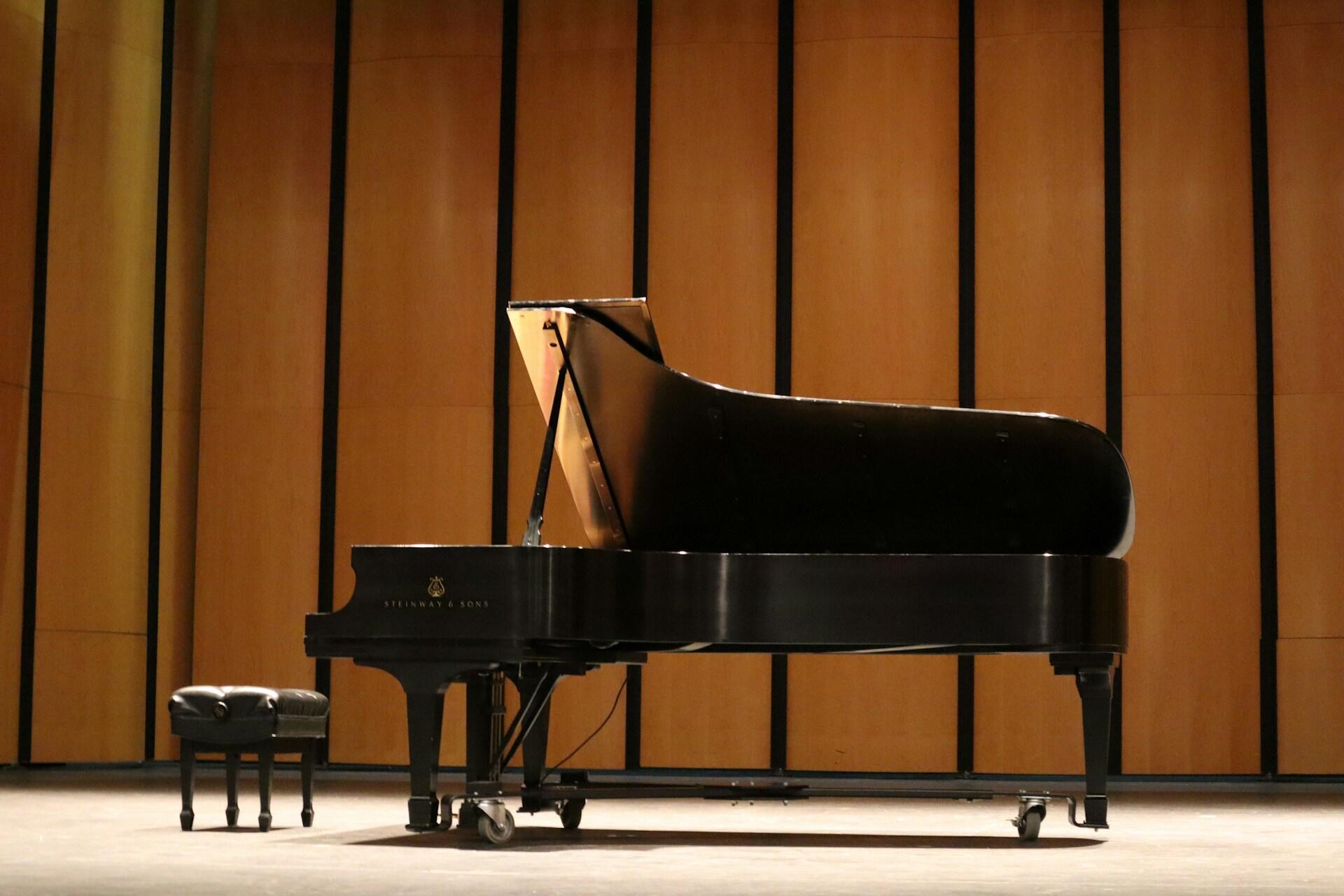There are certain piano songs that every pianist will want to learn at some point on their journey. From piano pieces by Mozart to chart-toppers by Adele and Alicia Keys, these pieces are excellent examples of what a piano is capable of. For centuries, in some cases, these famous piano songs have inspired students, professionals, and audiences. Some are simple, and others can only be mastered after dedicating your life to the instrument. Here are our 10 definitive piano works. If you have any additions of your own (and you will have!), let us know about them in the comments.
Mozart – Turkish March (Rondo alla Turca)
Few piano pieces are as instantly recognisable as Mozart's Turkish March. This is the third movement of his Piano Sonata No. 11 in A Major, composed in 1783 by a famous composer whose brilliance defined an era. The piece mimics the lively rhythms of Turkish Janissary bands.

Typically played around 116-130BPM, this rondo challenges pianists with quick runs and playful hand crossings. It's not advised for beginners, but it's a rewarding piece that intermediate players can start studying as they look to expand their skills.
Beethoven – Für Elise
You can't make a list of famous piano songs without Beethoven's Für Elise. This piece was composed in 1810 but published after Beethoven's death. This bagatelle in A minor is one of the most played pieces.
each year, supported by over 7,000 private teachers
It begins with a memorable motif that most pianists will learn in their very first lessons. Though the intro is accessible, the rest isn't as easy. As you go on, the passages are more intricate, requiring coordination and expression. If you're wondering who “Elise” is, that's still a mystery.
Debussy – Clair de Lune
This is one of those piano pieces that perfectly captures a distinct feeling. Debussy's Clair de Lune was first drafted in 1890 before being revised in 1905 as part of his Suite bergamasque.
Impressionism in music focuses on colour, texture, and mood rather than strict form. Composers like Debussy used unusual scales, soft dynamics, and flowing rhythms to create pieces that felt more like paintings in sound than structured sonatas.
A fine example of the Impressionist movement in music, it's written in D-flat major with a slow, flowing tempo of around 66-76BPM. The result is a dreamy sound with shifting harmonies and delicate dynamics. In terms of technique, it's relatively moderate, but it does take sensitivity and control to play well. Pianists should develop expression over speed for this one.
Chopin – Nocturne in E-flat Major, Op. 9 No. 2
This Romantic piano music was written around 1831-32. It's an excellent example of how Chopin could weave flowing melodies over gentle left-hand accompaniment. You can't play this with sheer speed, as you need phrasing and rubato.

Though the piece is set in E-flat major, it modulates, creating dramatic moments of tension. Advancing students are often taught this as a way to explore musical expression. Although Chopin created many incredible pieces, this one is easily the most famous and enduring of them all. Aspiring musicians who hope to become famous pianists often begin their journey with works like this, which teach both expression and discipline.
Ray Charles – Hit the Road Jack
Let's shift gears away from classical piano to something a bit different. Hit the Road Jack is an infectious piano song. It was written by Percy Mayfield in 1960 and made famous by Ray Charles in 1961. Its bluesy riff and swing tempo help make it really catchy.
The piano has been a central component of jazz since its earliest days. From stride and swing to bebop and soul, pianists provide rhythm, harmony, and improvisation. Playing jazz piano enhances your timing, chord knowledge, and ability to listen and respond in real-time.
The piece is in D minor, featuring a repeating chord progression with call-and-response vocals, which makes it really fun to learn. Intermediate players will enjoy mastering the rhythm, and even beginners can learn simplified versions of it.
John Lennon – Imagine

This is one of the simplest piano songs. John Lennon's Imagine was released in 1971 and became an anthem for peace. A straightforward progression in C major at around 75 BPM, its gentle rhythm provides the lyrics with ample room to shine.
on YouTube, proving the lasting cultural impact of a simple piano song.
Imagine is one of those songs that appears timeless and will likely never go out of fashion. Many famous piano players still include it in their performances, proving that even simple progressions can leave a lasting impact.
Adele – Someone Like You

There are lots of great piano songs in modern pop, but few have had as much impact as those of Adele. Someone Like You was released in 2011 and featured on her album 21. Its slow and straightforward piano part is playable by beginners and rewarding for more advanced pianists who can unlock its emotional depth. Instantly recognisable, the piano part helped make it a global success. Today, it's a great example of how contemporary music can still showcase the piano's remarkable qualities as a musical instrument.
Yann Tiersen – Comptine d’un autre été: L’après-midi
Film themes are often built on memorable melodies that are easier to play than dense concert works. Learning them develops expressive playing and helps students connect emotionally to the music—perfect for motivation at any stage of learning.
There are plenty of film scores with memorable piano pieces, but for most pianists, Yann Tiersen's soundtrack for Amélie is among the most famous. Comptine d'une autre été: L'après-midi was released in 2001, and the combination of the left-hand pattern and right-hand melody makes it popular amongst pianists, especially in airports and train stations, it seems. Intermediate pianists find it a rewarding challenge as they balance precision and expression.
Yiruma – River Flows in You
This is one of the most popular contemporary piano pieces, demonstrating that there's still space for classical (neo-classical, technically) music. Arpeggiated left-hand patterns combine with a tender right-hand melody to create a good piece for students between beginner and intermediate. Achieving fame as a modern classic, it has inspired many pianists worldwide to learn how to play.
Alicia Keys – If I Ain’t Got You
Alicia Keys' If I Ain't Got You (2004) features a soulful chord progression with heartfelt lyrics. The piano is relatively straightforward, but it does require sensitivity and a sense of groove. It's an excellent piece for intermediate players. If you're looking for inspiration closer to home, exploring the greatest pianists in the UK can give you a sense of just how far dedication to the instrument can take you.
| Song / Piece | Composer / Artist | Year | Genre | Key | Tempo (BPM) | Difficulty |
|---|---|---|---|---|---|---|
| Turkish March (Rondo alla Turca) | W.A. Mozart | 1783 (pub. 1784) | Classical, rondo | A major | 116–140 | Intermediate–Advanced |
| Für Elise | L. van Beethoven | 1810 (pub. 1867) | Romantic bagatelle | A minor | ~113 | Beginner (theme) / Intermediate+ (full) |
| Nocturne Op. 9 No. 2 | Frédéric Chopin | 1831–32 | Romantic nocturne | E♭ major | 60–72 | Intermediate |
| Clair de Lune | Claude Debussy | 1890 (rev. 1905) | Impressionist | D♭ major | 66–76 | Intermediate |
| Hit the Road Jack | Percy Mayfield / Ray Charles | 1961 | Soul / Jazz-Pop | D minor | 100–110 | Intermediate |
| Imagine | John Lennon | 1971 | Pop ballad | C major | ~75 | Beginner–Intermediate |
| Comptine d’un autre été | Yann Tiersen | 2001 | Film score | A minor | 70–80 | Intermediate |
| River Flows in You | Yiruma | 2001 | Neo-classical | F♯ minor (often A major simplified) | ~69 | Beginner–Intermediate |
| If I Ain’t Got You | Alicia Keys | 2004 | R&B / Pop ballad | G major | ~84 | Intermediate |
| Someone Like You | Adele & Dan Wilson | 2011 | Pop ballad | A major | ~67 | Beginner–Intermediate |
















